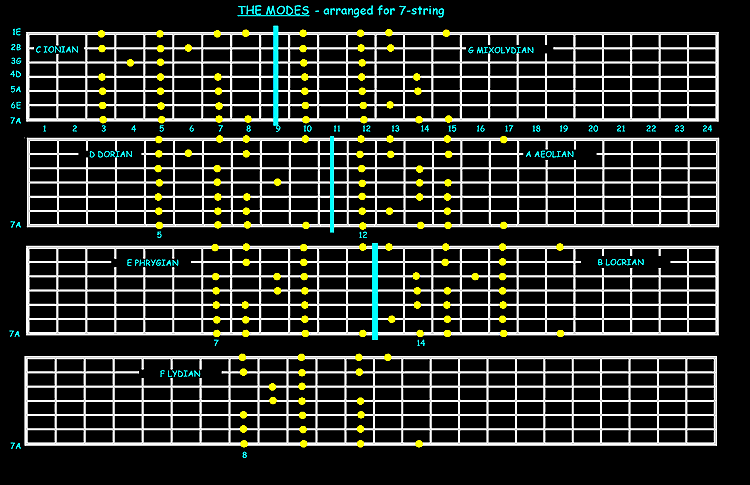I read Mike Overly’s bit about modes in an earlier edition of GNW. I thought my 7 string major scale modes template might be of some interest to those privileged few that wield 7 strings.
As if there arent already enough names for the scales and their notes, wannabee and initiate theorists will be interested to know that traditional academic types will still insist on referring to each note of traditional major and minor scales as 1=tonic , 2=supertonic, 3=mediant, 4=subdominant, 5=dominant, 6=submediant and 7=leading note.
Greek scholars will no doubt recognise the suffix “super” to mean “above” and suffix “sub” to mean “below”. For traditional compositional purposes the 5th note,5th triad and 5th mode( the mixolydian or dominant mode) were especially important and were bequeathed the title of “dominant” – rockers who specialize in powerchords [5th chords] would no doubt agree. The supertonic ( note 2) lies above the tonic[1 2] , hence its name.The mediant ( note 3) is the note which is midway [12 3 45] between the tonic and dominant, hence its name.
Remember the dominant was 5 notes above the tonic [1234 5], well the subdominant (note 4) is five notes below [8765 4]the tonic’s octave (note 8 and note 1 having the same name), hence its name.In the same way the mediant is 3 notes above the tonic [123] and the submediant is 3 notes below the tonic’s octave [876]. The 7th note of the scale likes to resolve to the tonic and is imaginately named the “leading note”. The tonic by the way is a word derived from the Greek word ” pitch” . Strange but true….

By Guy Pople, our 7 String Guy
